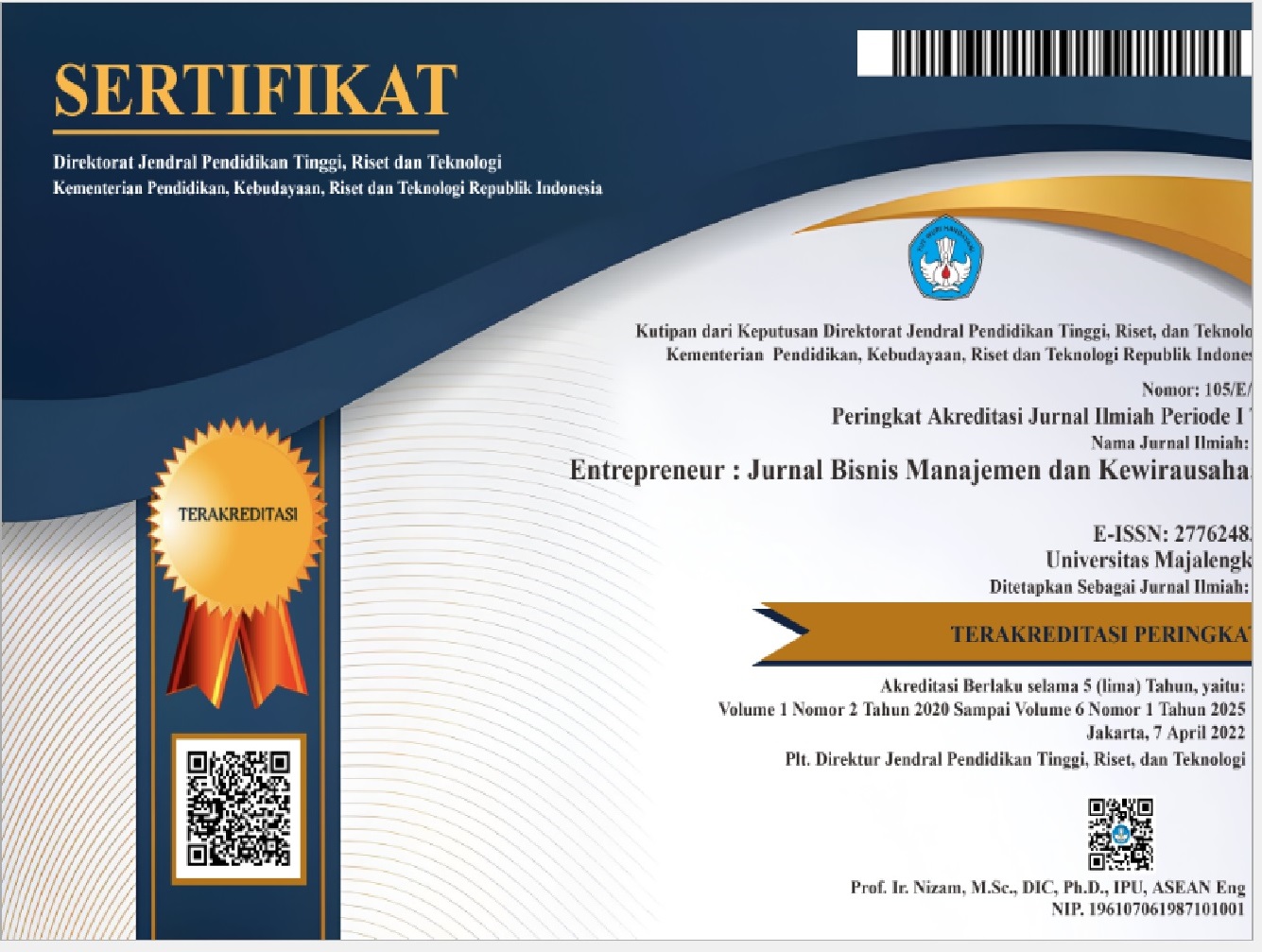Pengukuran Kinerja Perusahaan Menggunakan Metode Malcolm Baldrige (Studi Kasus: Divisi Assembly PT. XYZ)
DOI:
https://doi.org/10.31949/entrepreneur.v4i03.6924Abstract
This study aims to measure the performance of a shoe company, namely PT. XYZ, which is represented through the Assembly Division. The analytical method uses Malcolm Baldrige, with the type of research used is descriptive qualitative. The results of the study show that the performance measurement results in the Assembly Division are at the Average level with the title of Emerging Industry Leader. Based on the results of these measurements, it was found that some improvements were still needed, especially on the criteria that affect the financial results and the company's market as a whole. The Assembly Division plays a vital role in creating a product that will be sold to the market. Vertical and horizontal integration is urgently needed by the Assembly Division, in order to positively and sustainably improve performance for all other divisions. The implications of this research are expected to help the assembly division in particular to improve its performance. In addition, this research can be used as a benchmark for other divisions or PT XYZ as a whole to measure performance using the Malcolm Baldrige method, so that equity and company levels can be clearly identified
Keywords:
Measurement; Performance; Malcolm BaldrigeDownloads
References
Abdimomunova, L., & Valerdi, R. (2010). An Organizational Assessment Process in Support of Enterprise Transformation. Information Knowledge Systems Management, 9(3–4), 175–195. https://doi.org/10.3233/IKS-2010-0165
Ambarwati, R., & Supardi. (2020). Manajemen Operasional dan Implementasi Dalam Industri (Cetakan Pertama). Sidoarjo: UMSIDA Press.
Brown, M. G. (2014). Baldrige Award Winning Quality (8th Edition). London: CRC Press.
Denis, L. (2006). The Impact of Baldrige on Corporate Financial and Non Financial Performance. Conference: 18th Annual ASQ Quality Management Division Conference, March, 1–11.
Dsouza, S. C., & Sequeira, A. H. (2012). Application of Malcolm Baldrige Quality Framework to Enhance Performance in Healthcare Organisation. SSRN Electronic Journal, April, 1–11. https://doi.org/10.2139/ssrn.2037944
Erwan, & Dyah. (2011). Metode Penelitian Kuantitatif (Edisi Pertama). Yogyakarta: Gaya Media.
Jennifer, S. (2019). Using the Baldrige Leadership Model to Overcome Evasive Organizational Challenges. Chicago: Illinois.
Malcolm Baldrige National Quality Award (MBNQA). (2021). Baldrige Excellence Framework: A Systems Approach to Improving Your Organization’s Performance. Gaithersburg: US Department of Commerce National Institute of Standards and Technology.
Malcolm Baldrige National Quality Award (MBNQA). (2022). Baldrige Excellence Framework: Criteria for Performance Excellence. Gaithersburg: US Department of Commerce National Institute of Standards and Technology.
Moleong, J. L. (2007). Metodologi Penelitian Kualitatif. Bandung: Remaja Rosdakarya.
Sugiyono. (2012). Memahami Penelitian Kualitatif. Bandung: Alfabeta.
Published
How to Cite
Issue
Section
License
Copyright (c) 2023 Erwin Octau Herawan, Fathurohman, Aina Nindiani

This work is licensed under a Creative Commons Attribution-ShareAlike 4.0 International License.
COPYRIGHT NOTICE
An author who publishes in the Entrepreneur: Jurnal Bisnis Manajemen dan Kewirausahaan agrees to the following terms:
1. Author retains the copyright and grants the journal the right of first publication of the work simultaneously licensed under the Creative Commons Attribution-ShareAlike 4.0 License that allows others to share the work with an acknowledgment of the work's authorship and initial publication in this journal
2. The author is able to enter into separate, additional contractual arrangements for the non-exclusive distribution of the journal's published version of the work (e.g., post it to an institutional repository or publish it in a book) with the acknowledgment of its initial publication in this journal.
3. The author is permitted and encouraged to post his/her work online (e.g., in institutional repositories or on their website) prior to and during the submission process, as it can lead to productive exchanges, as well as earlier and greater citation of the published work








